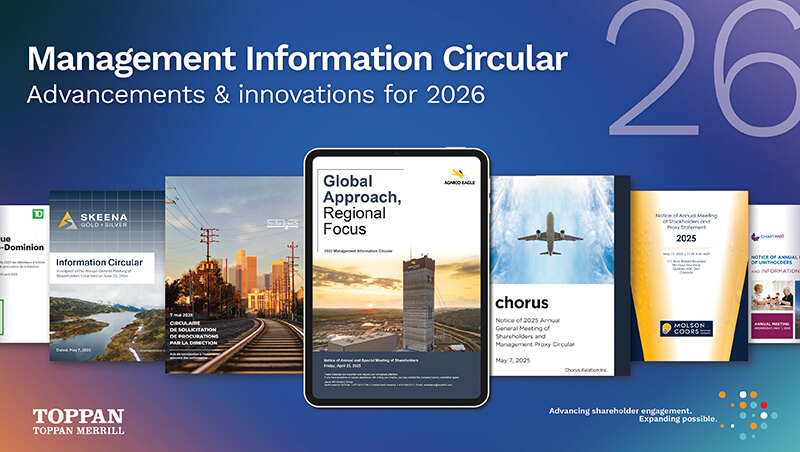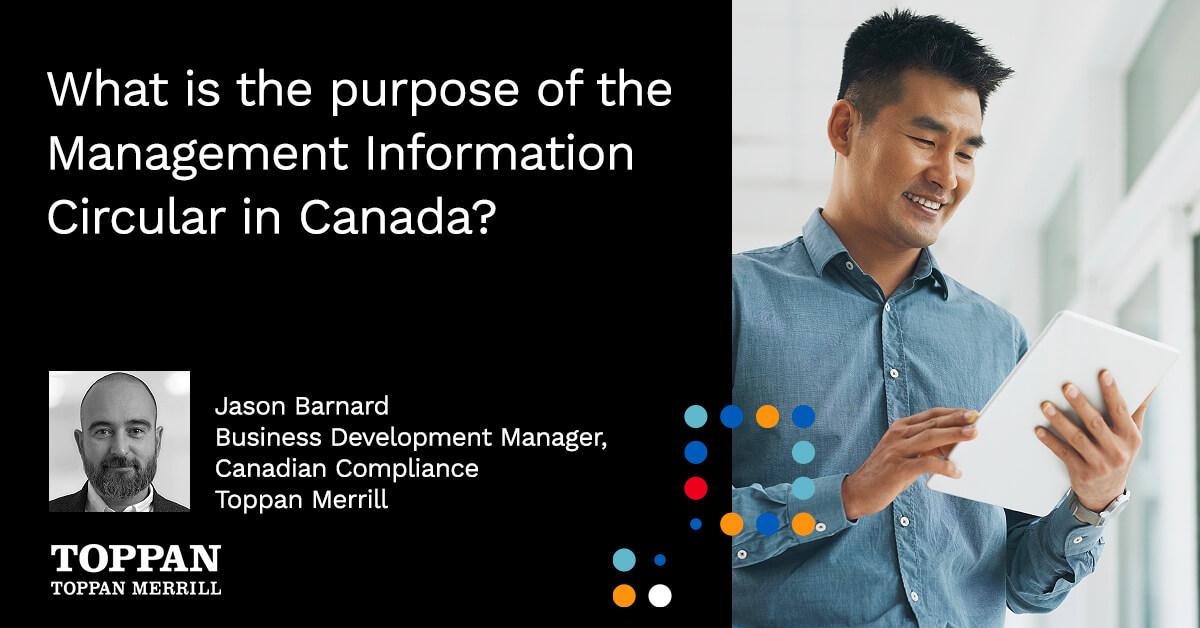Transcript
Scott:
Hello, I’m Scott Snyder, and joining me today is Jason Bernard, our go-to expert on understanding and navigating Management Information Circulars in our Canadian market here at Toppan Merrill. Following today’s session, you’ll walk away with insights into key trends we’ve seen this past season and what you can include to elevate your next circular. Jason, welcome to on the dot.
Jason:
Thanks, Scott. It’s great to be here.
Scott:
Jason, quickly for listeners who may not be familiar with you, could you share a few highlights of your own journey into this space?
Jason:
Yeah, for sure. So, my background’s always been in service, specifically in financial print. Early in my career, I learned the importance of project managing, meeting critical deadlines, and above all else building trust with my clients. And about 10 years ago, after managing a few major MIC upgrades in service, I realized I actually really enjoyed the process. I started following trends more closely, speaking with clients about what other issuers are doing, and offered suggestions and what they could do to bring those ideas into their own documents. It’s actually a lot of fun to see a circular move from basic checkbox disclosure into a document that clearly presents voting information, shareholder engagement, governance, and comp, while taking into consideration ease of navigation and brand. Today, I’m excited to talk through a few of those trends that we saw this year that can make a big impact for our clients in 2026.
Scott:
Terrific. So, yeah, Jason, I know in the, the new Management Information Circular style guide, we, you’ve identified eight hot topics. I don’t think we’ll have time to cover them all today, but let’s talk about some of those big things that are moving or that have moved here in 2025 and looking ahead to 2026.
Jason:
So they’re not just cosmetic updates. They really reflect a huge shift in how companies are communicating with investors. Everything from how shareholder letter is crafted to how comp data is presented. And today, I’m happy to walk through a few of those topics, but for listeners that want the full picture, please be sure to download the complete 2026 MIC style guide. It’s available now, and it includes real examples, ideas, for layout and a commentary on all the top trends.
Scott:
Terrific. Yeah, let’s jump into those shareholder letters. Jason, something you and I have talked about a lot, this is really undergone a transformation.
Jason:
Yeah. Oh, absolutely. One of the biggest shifts we continue to see in the shareholder letter is that it’s becoming much more personal, transparent and strategic. It’s not just a polite opening anymore. Rather it’s being used to set the whole tone for the circular. Companies are using this letter to speak directly to shareholders about what matters. It’s not just financial performance, but it’s governance priorities and board accountability. The tone is much more conversational, and the design’s certainly much more intentional. Ultimately, the shareholder letter has become a real opportunity for a strong first impression.
Scott:
Yeah. You know, you touch on design. It’s something I know that we really talk to clients a lot about. I, there’s some different examples here. This is really moving from what we’ve seen in the past.
Are there specific things that you see all the time? You know, we’ve got a few examples here, but just, talk a little bit further about that design aspect.
Jason:
Yeah, absolutely. So we continue to see a more reader friendly format, uh, very strong branding and type choices to create polishing uniform look. Companies are often including photos of either the executive with a chair to connect with the shareholder quotes or call out boxes can also be used to highlight key points. And there’s a very strong balance, again, between text and the visuals, which we both optimize for print and digital formats.
Scott:
Yeah, it looks great. Wow, what a transformation from where we, where we’ve been historically. Let’s, jump over to board skills though, and experience, another piece, you and I have talked about this has really changed a lot. And how those board members and their skills really come to life in the MIC.
Jason:
Yeah, no, absolutely. So we continue to see a strong interest from clients on how to improve board skills and experience in how they’re presented, particularly through a better organized skills matrix. This format provides a quick visual reference, which is much easier to follow compared to a text that’s just buried in the narrative. I always do recommend including brief descriptions for each of the skills, especially since terms can vary so much between industries. For ease of reference, the definitions can either be integrated directly into the skills matrix or certainly placed on the previous or following pages.
Scott:
So Jason, this is, this is a really nice visual way to really see the skills, but it’s the alignment, right, with each board member and what that board member brings to the conversation or, or to the company, as it were.
Jason:
Yeah, you’re absolutely right, Scott. A well-organized skills matrix doesn’t just show what skills exists, but what it does to add to the overall narrative and to support how each of the board members align with the company’s strategic goals, it helps shareholders to understand how the board is equipped to oversee key issues and ensure that the right experience is in place to support those long-term performance goals.
Scott:
Yeah, fantastic. Again, another really significant shift in how the MIC is constructed. Let’s jump over to compensation, always a hot topic, and how it’s presented. Obviously, we’re seeing some new trends here as well. Can you talk about what’s really changing here to highlight compensation in the right way?
Jason:
Absolutely, and I mean, we could talk about comp forever, but I’m going focus on one thing, and that is the highlight section. So we’re seeing more and more companies include a highlight section at the start of executive comp. It’s often just a one-page summary, but it’s not just to show the numbers. It’s a clear outline, really, of comp philosophy and objectives that you can find upfront. This section can summarize approach to pay for performance, high light alignments with shareholder interests, and potentially describe how decisions are made. And it’s a great way to show transparency early into this section without making shareholders dig through the entire CDNA.
Scott:
So, Jason, we’ve talked about three topics, three trends. Obviously, there’s, many more to, to uncover, which we’ve outlined in our management information circular guide. But just a couple of final thoughts from you, the things that you’re seeing or, or best practices being applied by a lot of companies in their MIC?
Jason:
Yeah, for sure. I continue to encourage enhanced navigation as part of a navigation bar. I love full color throughout the entire circular. Again, I love seeing corporate branding as much as possible, so the documents really feel like they belong. We also encourage our clients to work with us to remediate their documents to the Canadian Accessibility Standards, which makes the shareholders and material available for all.
Scott:
Jason, great insight and again, a reminder for all of our listeners and our viewers. You can certainly download the guide, the QR code there on the screen, and we would encourage you to take a look at the best practices that we’ve, included for the 2026 version of the guide. Jason, thanks for joining me for On The Dot today, and we’ll look forward to catching up with you again in the coming months.
Jason:
Thanks, Scott.
Overview
On The Dot (episode 11) – A conversation with MIC expert Jason Barnard as he shares key trends to elevate your 2026 Management Information Circular.
At a glance
- Shareholder letters: personal, transparent, strategic
- Design: branding, visuals, board skills matrices
- Compensation: highlight sections for clarity and transparency
- Best practices: navigation, color, accessibility

From filing to design and typeset, receive expert support on your MIC regardless of the workflow.
Offering filing, print-only option, typeset, and design, and we have experts in HTML to support SEDAR+ & EDGAR workflow for Foreign Private Issuers.
